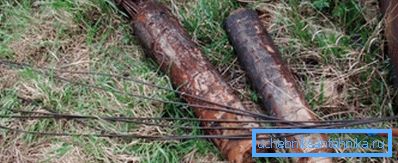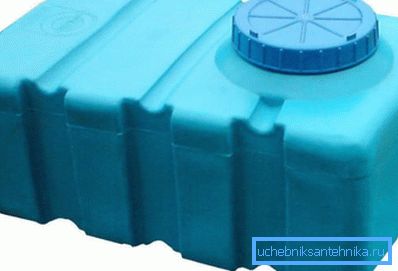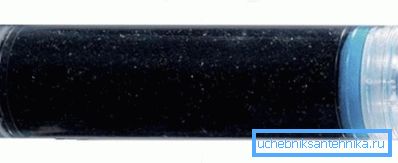Why does well water turn yellow and how to deal with it
On your own plot you can and should afford such a wonderful luxury as a well. The abundance of free water for garden needs, ensuring the work of the bathroom, washing machine, shower and drink. The latter is especially relevant in light of the fact that the daily rate of N2About for an adult is 2 liters, and they need somewhere to take.
But sometimes after the completion of drilling, we see that the water from the well turns yellow. This is a clear sign of its unsuitability for use, and even more so, such liquid can damage expensive plumbing. In this article we will look at the causes of such an incident and how to deal with it.

Causes and methods of counteraction
The first thing you need is a complete analysis of a suspicious fluid. Then you can choose the most effective solution to the problem. Otherwise, you can "fight the mills" and not having solved the true problem.
Even in the case of normal color it is better not to save and find out what you are going to use for many years. Since the consumption of low-quality water produces a cumulative effect, gradually destroying the body.
Rust

Yellow water in the well may be due to an excess of iron and oxygen, the combination of which leads to the corrosion process. Thus, rust can flow not only from the public water supply system, but also from a home underground source..
There are two situations:
- Increasing the amount of iron due to the proximity of red, copper or other types of iron ore leads to the inevitable chemical reaction with oxygen and the subsequent change in the color of the liquid. As a result, she loses her taste and healthy qualities.
- Contact of oxygen with the metal of pipes and other elements of the water supply system from the well located at the bottom of the mine. It can be rings, filter mesh fasteners.

The following instruction will help you in eliminating this effect:
- Install a sealed polyethylene cap on the well. It will significantly limit the intake of oxygen inside, and without it the process of corrosion will not begin.
- Reagent filtration of water using appropriate equipment. In this case, care must be taken, since if the reagent ratio is incorrect, the well may become unusable for a long time.
- You can also make more simple deferrization with your own hands:
- Install a plastic or stainless steel tank in the attic.

- To him we bring a hose from the pumping station.
- A few centimeters above the bottom we make an outlet.
- We conduct from him a water pipe around the house.
- We fill the tank with water and let it settle, with the result that all the rust will precipitate and the net H will disperse throughout the house.2ABOUT.
Although a certain amount of iron must necessarily be in the composition of water, as it accompanies the process of oxygen transfer through the human circulatory system, but the excess must be removed.
Tip: for the prevention of rust is recommended to use pipes and filters made of plastic, not iron, especially since their price is even lower. Then there will be only possible impurities of iron in the liquid itself.

Sand
When a well is drilled on a sandy aquifer, very fine sand can be caught that will penetrate the bottom filter screen. And then yellow water from the well awaits you too..

In this case, you can take the following measures:
- Install a coarse filter system at the outlet. Take into account the size of the particles and remember the need for regular washing.
- Initially, install a depth filter for a well with a finer grid. It is quite possible to foresee, knowing what type of well you are going to drill.
Tip: it is recommended to maintain a well drilled in sandstone, use a pump designed to pump liquid with impurities. This will prevent breakage of the pump if sand particles get into the casing.
Clay
In case of making mistakes in the process of drilling and installation of equipment, the edge of the pipe with filter may get into the clay. Also, this contributes to the weak filling of the bottom of the mine with rubble. Clay particles, getting into the liquid, will begin to paint it in a brown shade..
To eliminate this problem, you need to take two steps:
- Well pump well, removing clay from it. The most optimal result will bring the option with two pumps:
- We immerse one device on the bottom and draw a hose from it into a special container with a net for cleaning the liquid.
- We install the second pump on top of the surface and turn it on to distill the purified water from the container under pressure back to the mine.
- Such a peculiar water hammer will help to wash the necessary amount of clay for its subsequent removal by a pumping pump.

- Replace or strengthen gravel bottom filter. It is he who creates favorable conditions for high-quality water intake.
So the problem is eliminated completely, without disturbing you in the future, unlike sand and iron, which you will have to fight regularly.
Tannin
This substance or humus acid may be present in groundwater and is completely harmless to the human body. But when interacting with many filtration systems, or rather with their cleansing components, they paint the water in the ill-fated yellow color with all the ensuing consequences.
The solution to this problem will be the use of carbon filters.

Conclusion
The perfect complement to your well-shaped plot can be overshadowed by the presence of yellow water. Immediately analyze the fluid to detect if it contains harmful substances. The cost of laboratory work is much lower than the possible negative consequences of neglect of the problem.

There are a number of the most common reasons for this behavior of water:
- excess iron
- fine sand,
- drilling error,
- and the presence of tannin.
In all cases, you can fight with alternate success. The main thing is not to stop and carry out maintenance work at least once a year, even if the plumbing system is satisfactory.
The video in this article will give you the opportunity to read more information on the subject. Clean water in the house - the key to your health! Watch the condition of your well and eliminate any malfunctions in time.